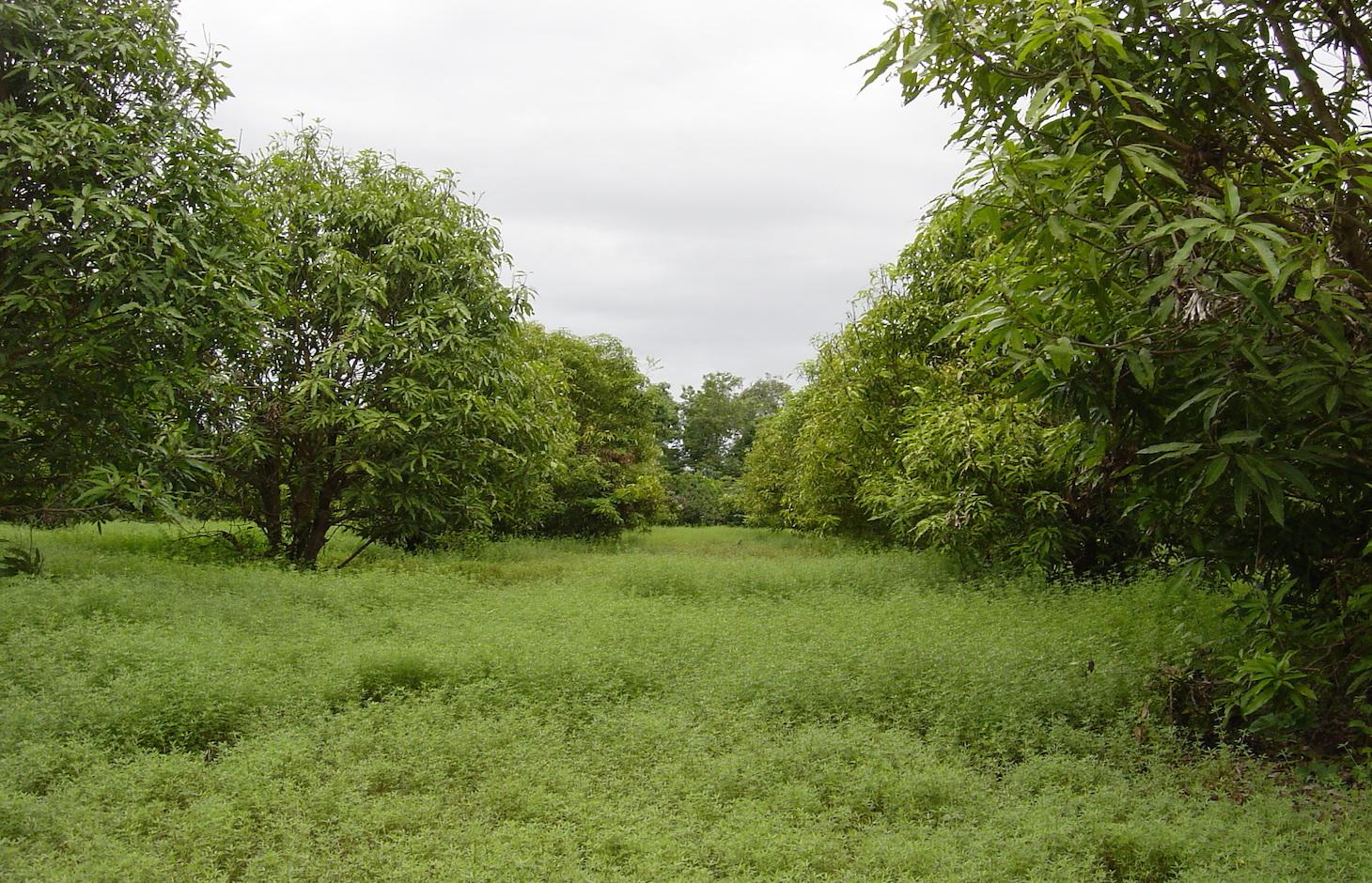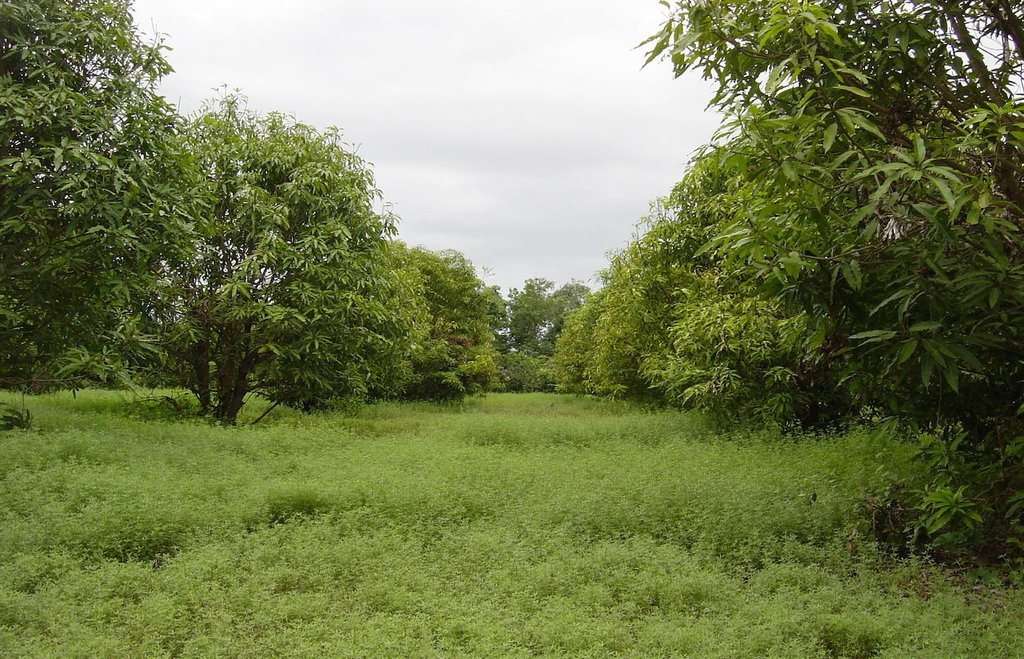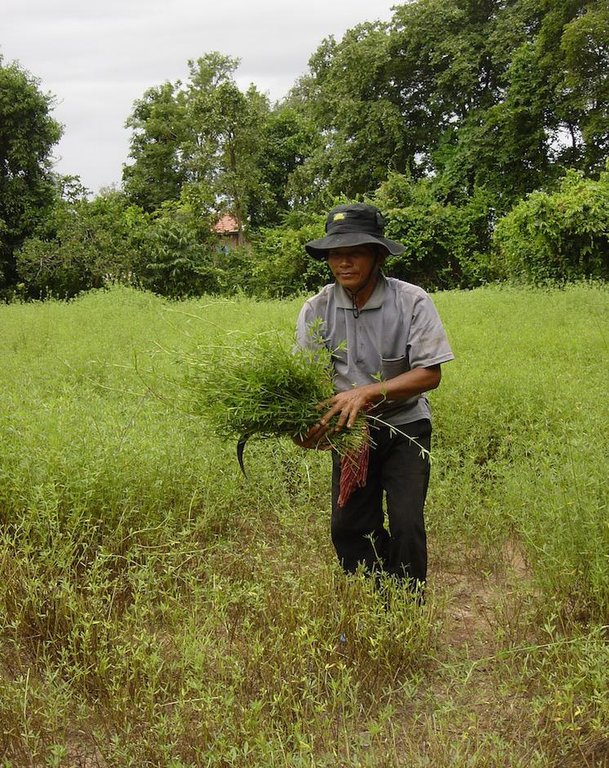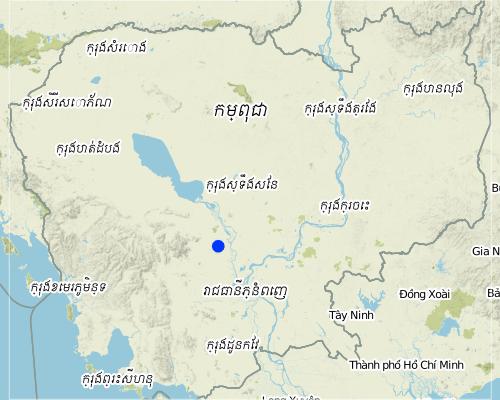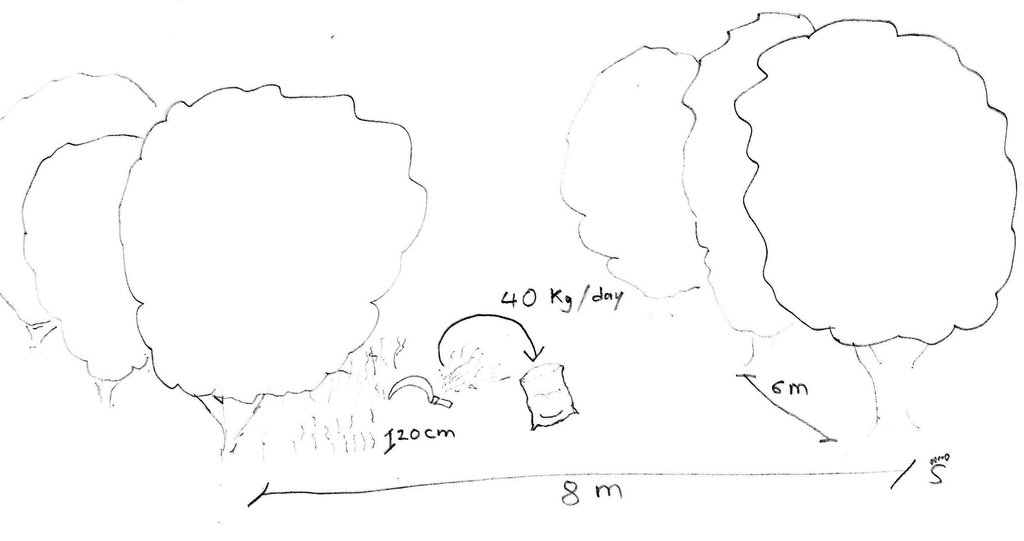Growing stylo grass (Stylosanthes guianensis) as cattle fodder between and under mango trees. [Камбодж]
- Шинийг нээх:
- Шинэчлэх:
- Эмхэтгэгч: Christoph Kaufmann
- Хянан тохиолдуулагч: –
- Хянагч: Deborah Niggli
ការដាំស្មៅជាចំណីសត្វ (Stylosanthes guianensis) ទៅតាមចន្លោះដើមស្វាយ (Khmer)
technologies_1642 - Камбодж
Бүлгүүдийг үзэх
Бүгдийг дэлгэх Бүгдийг хаах1. Ерөнхий мэдээлэл
1.2 Технологийг үнэлэх, баримтжуулах ажилд хамаарах мэдээлэл өгсөн хүмүүс, байгууллагуудын холбоо барих мэдээлэл
1.3 ВОКАТ-аар баримтжуулсан өгөгдлийг ашиглахтай холбоотой нөхцөл
Мэдээллийг хэзээ (газар дээр нь) цуглуулсан бэ?
14/07/2014
Эмхэтгэгч болон гол мэдээлэгч хүн(хүмүүс) WOCAT аргачлалаар баримтжуулсан мэдээллийг ашиглахтай холбоотой нөхцлийг хүлээн зөвшөөрсөн:
Тийм
1.4 Технологи тогтвортой гэдгийг баталгаажуулах
Энэ технологийг газрын доройтлыг бууруулж, газрын тогтвортой менежментийг хангахад тохиромжтой гэж үзэж болох уу?
Үгүй
2. ГТМ Технологийн тодорхойлолт
2.1 Технологийн товч тодорхойлолт
Технологийн тодорхойлолт:
Stylo grass (Stylosanthes guianensis) is grown under and between mango trees to be used as fodder for cattle.
2.2 Технологийн дэлгэрэнгүй тодорхойлолт
Тодорхойлолт:
Stylo grass (Stylosanthes guianensis, CV. Stylo 184) is a leguminous shrub which is used in pastures and as fodder crop. It is drought tolerant and can be harvested during the whole year, though it grows only when sufficient water is available. Mangos (Mangifera indica) are grown mainly from seeds in the area, either as single trees in home gardens or as orchards. The farmer of this case study has a mango orchard of 0.6 ha with trees spaced 6 by 8 meters, and grows stylo grass as a cover crop under and between the trees. Each day a patch of stylo grass is harvested by hand, and around 40 kg of this fodder is fed to the cattle together with rice straw. This allows the farmer to keep more cattle than before, 11 heads instead of 5. The mangos are mainly sold on the market, and some are dried. This agroforestry system reduces erosion by wind and water, as the soil is covered the whole year and the trees slow down the wind. The cattle can be kept near the house, which is good for making compost and biogas.
In 2004, the farmer cleared a forest and planted mango seedling. Between the mangos, he grew pumpkins, watermelons and cucumbers, but even though he used compost the soil fertility deteriorated fast and the cucurbits did not produce anymore. A local NGO, LAREC (Local Agricultural Research and Extension Centre), was looking for farmers with enough cattle and land in the area to try stylo grass, which was unknown in the area. The farmer, first reluctant because his other crops were not producing, started to plant stylo grass seeds he got from the NGO in July 2013 (information for this documentation was collected one year after the start).To do so, he plouwed and harrowed the fields with the hand tractor, and broadcasted the seeds by hand. After the first 3 months, during which he needed to weed, he started harvesting the fodder, and he cut 40 kg a day, one patch after another, 20 cm from the soil. This allows the reproduction of this cover crop.
The land user wants to expand his stylo grass to his other mango orchard, and is collecting seeds for this. Other farmers in the area are also interested in this technology; and the land user of this case-study starts to sell them stylo grass seeds but does not produce enough for all yet.
The analysed area is mostly flat (slope < 2%), tropic (dry and wet season), and the soils are mostly sandy or loamy. The soils contain little organic matter (low soil fertility, acidification, small amount of cattle, area has been deforested) and the groundwater table is rather high (3 m below soil level during the dry season, on the surface during the wet season).
Due to climate change, the rainfalls are more erratic, temperatures rise and droughts are more recurrent. Rice is the predominant crop grown in the area, since it serves as staple food (mix subsistence and commercial activities). Rice is often grown in monocultures and harvested once a year. Once the rice is harvested (dry season), some farmer release cattle to the paddy fields to eat the straw and weeds.
As an addition to rice, most land users grow vegetable and fruits in small home gardens (subsistence) and complement their income by producing handicrafts or through off farm income / remittances from family members working in other places. The increasing migration rate (the young generation leaves the villages to work in the cities, garment industry or abroad) results in a decrease of available labour force in the area which has detrimental effects on the agricultural activities. Furthermore, the civil war in the 1970s (Khmer Rouge) led to the loss of agricultural knowledge which different NGOs try to re-establish.
2.3 Технологийн гэрэл зураг
2.5 Энэ үнэлгээнд хамрагдсан технологийг хэрэгжүүлсэн улс орон/ бүс нутаг/ байршил
Улс:
Камбодж
Улс/аймаг/сум:
Kampong Chhnang
Байршлын дэлгэрэнгүй тодорхойлолт:
Sre Ouk Samlor Sap/Taing Krasaing/Rolear Pha,er
Map
×2.6 Хэрэгжсэн хугацаа
Байгуулсан тодорхой оныг мэдэхгүй бол баримжаа хугацааг тодорхойл:
- <10 жилийн өмнө (саяхны)
2.7 Технологийн танилцуулга
Технологийг хэрхэн нэвтрүүлснийг тодорхойл:
- Гадны төсөл/хөтөлбөрийн дэмжлэгтэйгээр
Тайлбар (төслийн төрөл г.м.):
It started in July 2013 when SOFDEC gave stylo grass seeds to farmers with enough cattle and land
3. ГТМ технологийн ангилал
3.1 Технологийн үндсэн зорилго (ууд)
- үйлдвэрлэлийг сайжруулах
- газрын доройтлыг бууруулах, сэргийлэх, нөхөн сэргээх
3.2 Технологи нэвтрүүлсэн газрын одоогийн газар ашиглалтын хэлбэр(үүд)

Холимог (тариалан/бэлчээр/мод), үүнд. ХАА-н ойжуулалт
- ХАА-н ойжуулалт
Тайлбар:
Major land use problems (compiler’s opinion): Lack of organic matter, lack of water retention in soil, irregularity of rainfall, low soil fertility (sandy soil), monocultures, bare soil during dry season.
Major land use problems (land users’ perception): Low soil fertility, lack of water, soil erosion by water on the slope.
Хэрэв технологи нэвтрүүлснээр газар ашиглалтад өөрчлөлт гарсан бол технологи нэвтрүүлэхээс өмнө байсан газар ашиглалтын хэлбэрийг тодорхойлно уу:
Cropland: Ct: Tree and shrub cropping
3.3 Газар ашиглалтын тухай нэмэлт мэдээлэл
Технологи хэрэгжүүлсэн газрын усан хангамж:
- Байгалийн усалгаатай
Жилд ургамал ургах улирлын тоо:
- 1
Тодорхойлно уу:
Longest growing period in days: 210Longest growing period from month to month: June-December
3.4 Технологи ГТМ-ийн аль бүлэгт хамаарах вэ
- ХАА-н ойжуулалт
3.5 Технологийн хамрах талбай
Технологи өргөн дэлгэрсэн эсхийг тодорхойл:
- газар дээр жигд тархсан
Технологи газар нутгийн хэмжээнд жигд тархсан бол түүний эзлэх талбайг дундажаар тооцож тэмдэглэ:
- < 0.1 км2 (10 га)
Тайлбар:
0.6 ha
3.6 Технологийг бүрдүүлэх ГТМ арга хэмжээ

Ургамлын арга хэмжээ
- V2: Өвс ба олон наст өвслөг ургамал

Менежментийн арга хэмжээ
- М1: Газар ашиглалтын хэлбэрийг өөрчлөх
Тайлбар:
Type of vegetative measures: aligned: -linear
3.7 Технологид харгалзах газрын доройтлын төрөл

хөрс усаар эвдрэх
- Wt: Хөрсний гадаргын угаагдал

хөрсний химийн доройтол
- Cn: Үржил шим ба ялзмаг буурах (элэгдлийн шалтгаангүй)

биологийн доройтол
- Bc: Ургамлан нөмрөг багасах
- Bq: биомасс буурах
Тайлбар:
Main causes of degradation: soil management (Soil left bare during the dry season.), deforestation / removal of natural vegetation (incl. forest fires) (Deforestation in 2004)
Secondary causes of degradation: population pressure (.New areas are deforested, and are degraded after a few years.), inputs and infrastructure: (roads, markets, distribution of water points, other, …) (Lack of irrigation.)
3.8 Газрын доройтлоос урьдчилан сэргийлэх, сааруулах ба нөхөн сэргээх
Газрын доройтолтой холбоотойгоор Технологи ямар зорилго тавьсан болохыг тодорхойл:
- Газрын доройтлыг бууруулах
- Хүчтэй доройтсон газрыг нөхөн сэргээх/ сайжруулах
4. Техникийн нөхцөл, хэрэгжүүлсэн үйл ажиллагаа, материал ба зардал
4.1 Технологийн техник зураг
4.2 Техникийн үзүүлэлт/ техникийн зургийн тайлбар
Stylo grass is harvested daily between the mango trees, one patch after another. This allows different stages of growth.
Kampong Chhnang
Date: 2014
Technical knowledge required for field staff / advisors: low
Technical knowledge required for land users: low
Main technical functions: increase of biomass (quantity), promotion of vegetation species and varieties (quality, eg palatable fodder)
Secondary technical functions: improvement of ground cover, increase in nutrient availability (supply, recycling,…)
Aligned: -linear
Vegetative material: T : trees / shrubs
Number of plants per (ha): 200
Vertical interval between rows / strips / blocks (m): 8
Vertical interval within rows / strips / blocks (m): 6
Vegetative measure: Covering the soil
Vegetative measure: Vegetative material: G : grass
Trees/ shrubs species: Mangoes, Mangifera indica. Planted.
Grass species: Stylo grass, Stylosanthes guianensis. Seeded.
4.3 Материал болон зардалд хамаарах ерөнхий мэдээлэл
Хөлсний ажилчны нэг өдрийн цалингийн хэмжээг тодорхойлно уу:
5.00
4.4 Бий болгох үйл ажиллагаа
| Үйл ажиллагаа | Арга хэмжээний төрөл | Хугацаа | |
|---|---|---|---|
| 1. | Plow the field, dig holes and plant mango seedlings. | Ургамлын | Once at the beginning of the wet season (May-June) |
| 2. | Sow stylo grass. | Ургамлын | Once in July. |
| 3. | Weeding | Ургамлын | first 3 months |
4.5 Бий болгоход шаардагдсан зардал, хөрөнгийн өртөг
| Зардлын нэр, төрөл | Хэмжих нэгж | Тоо хэмжээ | Нэгжийн үнэ | Зардал бүрийн нийт өртөг | Нийт дүнгээс газар ашиглагчийн төлсөн % | |
|---|---|---|---|---|---|---|
| Хөдөлмөр эрхлэлт | Labour | ha | 1.0 | 21.25 | 21.25 | 100.0 |
| Тоног төхөөрөмж | machine use | ha | 1.0 | 100.0 | 100.0 | 100.0 |
| таримал материал | seeds | ha | 1.0 | 8.0 | 8.0 | |
| таримал материал | seedlings | ha | 1.0 | 200.0 | 200.0 | 100.0 |
| Бордоо ба биоцид | fertilizer | ha | 1.0 | 28.0 | 28.0 | 100.0 |
| Технологи бий болгох нийт үнэ өртөг | 357.25 | |||||
4.6 Арчилгаа/ урсгал үйл ажиллагаа
| Үйл ажиллагаа | Арга хэмжээний төрөл | Хугацаа/ давтамж | |
|---|---|---|---|
| 1. | Harvest 40 kg of stylo grass. | Ургамлын | 1h/d |
| 2. | Harvest mangoes | Ургамлын | April-May |
| 3. | Maintain the stylo grass, sowing bare spots | Ургамлын | 2 person days per month |
4.7 Арчилгаа/урсгал ажилд шаардагдсан зардал, хөрөнгийн өртөг (нэг жилд)
| Зардлын нэр, төрөл | Хэмжих нэгж | Тоо хэмжээ | Нэгжийн үнэ | Зардал бүрийн нийт өртөг | Нийт дүнгээс газар ашиглагчийн төлсөн % | |
|---|---|---|---|---|---|---|
| Хөдөлмөр эрхлэлт | Labour | ha | 1.0 | 590.0 | 590.0 | 100.0 |
| Технологийн арчилгаа/урсгал үйл ажиллагаанд шаардагдах нийт үнэ өртөг | 590.0 | |||||
Тайлбар:
The costs were calculated in 2014 for an area of 0.6 ha. The farmer got 100’000 riel (25US$) for the 800 – 1000 kg mangoes produced, and a bag of fodder (40 kg, that he harvests each day on 0.6 ha) can be sold for around 5000 riel (1.25) on the market.
4.8 Зардалд нөлөөлж байгаа хамгийн чухал хүчин зүйл
Өртөг, зардалд нөлөөлөх гол хүчин зүйл:
The costs were calculated as if he hired someone, and bought mango seedlings. As he did all of the work by himself, it was much cheaper. The most expensive is the harvesting of the fodder, but it should be taken into account that it is less labour intensive than harvesting wild grasses and cheaper than buying them.
5. Байгаль ба нийгмийн нөхцөл
5.1 Уур амьсгал
Жилийн нийлбэр хур тундас
- < 250 мм
- 251-500 мм
- 501-750 мм
- 751-1,000 мм
- 1,001-1,500 мм
- 1,501-2,000 мм
- 2,001-3,000 мм
- 3,001-4,000 мм
- > 4,000 мм
Хур тунадасны талаархи тодорхойлолт/ тайлбар:
1486.45 mm 2013 in Kampong Chhnang
Агро-уур амьсгалын бүс
- чийглэг
27° to 35°C
5.2 Гадаргын хэлбэр
Дундаж налуу:
- хавтгай (0-2 %)
- бага зэрэг налуу (3-5 %)
- дунд зэрэг налуу (6-10 % )
- хэвгий (11-15 %)
- налуу (16-30 %)
- их налуу (31-60 % )
- эгц налуу (>60 %)
Гадаргын хэлбэр:
- тэгш өндөрлөг / тал
- нуруу
- уулын энгэр
- дов толгод
- бэл
- хөндий
Өндрийн бүслүүр:
- 0-100 д.т.д. м.
- 101-500 д.т.д. м.
- 501-1,000 д.т.д м.
- 1,001-1,500 д.т.д м.
- 1,501-2,000 д.т.д м.
- 2,001-2,500 д.т.д. м.
- 2,501-3,000 д.т.д. м.
- 3,001-4,000 д.т.д м.
- > 4,000 д.т.д. м.
5.3 Хөрс
Хөрсний дундаж зузаан:
- маш нимгэн (0-20 см)
- нимгэн (21-50 см)
- дунд зэрэг зузаан (51-80 см)
- зузаан (81-120 cм)
- маш зузаан (>120 cм)
Хөрсний бүтэц (өнгөн хөрс):
- бүдүүн/ хөнгөн (элсэрхэг)
Өнгөн хөрсөнд агуулагдах ялзмаг:
- дунд (1-3 % )
- бага (<1 % )
5.4 Усны хүртээмж ба чанар
Гүний усны түвшин:
< 5 м
Гадаргын усны хүртээмж:
хангалтгүй/ байхгүй
Усны чанар (цэвэршүүлээгүй):
муу чанарын ундны ус (цэвэршүүлэх шаардлагатай)
Усны чанар, нөөцийн талаархи тайлбар ба бусад тодорхойлолт:
availability of surface water poor durin dry seasons
5.5 Биологийн олон янз байдал
Зүйлийн олон янз байдал:
- Бага
5.6 Технологи нэвтрүүлсэн газар ашиглагчдын тухай мэдээлэл
Суурьшмал эсвэл нүүдлийн:
- Суурьшмал
Үйлдвэрлэлийн системийн зах зээлийн чиг баримжаа:
- холимог (амь зуух/ худалдаа наймаа
Бусад эх үүсвэрээс олох орлого:
- Нийт орлогын 10-50 %
Чинээлэг байдлын түвшин:
- чинээлэг
Хувь хүн эсвэл бүлэг:
- Хувь хүн / өрх
Механикжилтын түвшин:
- гар ажил
- механикжсан / мотортой
Хүйс:
- эрэгтэй
Газар ашиглагчдын бусад шинж чанарыг тодорхойл:
Land users applying the Technology are mainly Leaders / privileged
Difference in the involvement of women and men: Only one man is applying the technology, his wife works in the garment industry.
Population density: 10-50 persons/km2
Annual population growth: 0.5% - 1%
Off-farm income specification: His wife works in a factory.
5.7 Технологи нэвтрүүлсэн газар ашиглагчийн өмчилж буй, эзэмшиж буй, түрээсэлж буй эсвэл ашиглаж буй (ашиглах эрх) газрын талбай
- < 0.5 га
- 0.5-1 га
- 1-2 га
- 2-5 га
- 5-15 га
- 15-50 га
- 50-100 га
- 100-500 га
- 500-1,000 га
- 1,000-10,000 га
- > 10,000 га
Энэ талбай том, жижиг, дунд алинд хамаарах вэ (орон нутгийн нөхцөлд харгалзуулна уу)?
- дунд-хэмжээний
5.8 Газар эзэмшил, газар ашиглах эрх, ус ашиглах эрх
Газар өмчлөл:
- нэгдлийн/ тосгон
- хувь хүн, өмчийн гэрчилгээгүй
Газар ашиглах эрх:
- нэгдлийн хэлбэрээр (зохион байгуулалттай)
- хувь хүн
Ус ашиглах эрх:
- нээлттэй хүртэх (зохион байгуулалтгүй)
Тайлбар:
Land ownership is very complex. Most of the land belongs officially to the government, yet many land users hold a paper confirming they applied for a land title – but de iure, this paper is worthless.
5.9 Дэд бүтэц, үйлчилгээний хүртээмж
эрүүл мэнд:
- ядуу
- дунд зэргийн
- сайн
боловсрол:
- ядуу
- дунд зэргийн
- сайн
техник зөвлөгөө:
- ядуу
- дунд зэргийн
- сайн
хөдөлмөр эрхлэлт (жишээ нь, ХАА-аас өөр):
- ядуу
- дунд зэргийн
- сайн
зах зээл:
- ядуу
- дунд зэргийн
- сайн
эрчим хүчний хангамж:
- ядуу
- дунд зэргийн
- сайн
зам тээвэр:
- ядуу
- дунд зэргийн
- сайн
усан хангамж ба ариутгал:
- ядуу
- дунд зэргийн
- сайн
санхүүгийн үйлчилгээ:
- ядуу
- дунд зэргийн
- сайн
6. Үр нөлөө ба дүгнэлт
6.1 Технологийн талбайд үзүүлсэн нөлөө
Нийгэм-эдийн засгийн үр нөлөө
Үйлдвэрлэл
тэжээл үйлдвэрлэл
тэжээлийн чанар
малын бүтээмж
үйлдвэрлэлийн газар
Орлого, зарлага
орлогын олон янз эх үүсвэр
Нийгэм-соёлын үр нөлөө
хүнсний аюулгүй байдал/ өөрийн хэрэгцээг хангах
Contribution to human well-being
Тайлбар/ тодорхой дурьдах:
Less time needs to be invested in harvesting wild grasses.
Экологийн үр нөлөө
Хөрс
хөрсөн бүрхэвч
хөрс алдагдах
Тайлбар/ тодорхой дурьдах:
No wind erosion because of the soil cover, less water erosion.
шимт бодисын эргэлт/ сэргэлт
Тайлбар/ тодорхой дурьдах:
Stylo gras is a leguminous, thus fixes nitrogen.
хөрсний органик нэгдэл/ хөрсөнд агуулагдах карбон
Тайлбар/ тодорхой дурьдах:
The mango leaves fall to the soil and increase the organic content.
Биологийн олон янз байдал: ургамал, амьтан
газрын дээрхи / доорхи карбон
Уур амьсгал болон гамшгийн эрсдлийг бууруулах
салхины хурд
Тайлбар/ тодорхой дурьдах:
The mango trees slow down the wind
6.2 Технологийн талбайн гадна үзүүлсэн үр нөлөө
голын адагт лаг шавар хуримтлагдах
салхиар тээвэрлэгдэх хурдас
Fields need to be fenced because of the neighbour's cattle
Тайлбар/ тодорхой дурьдах:
The living fence was already planted before.
6.3 Технологийн уур амьсгалын өөрчлөлт, цаг агаарын гамшигт үзэгдэлд өртөх байдал ба эмзэг байдал (газар ашиглагчийн бодлоор)
Уур амьсгалын аажим өөрчлөлт
Уур амьсгалын аажим өөрчлөлт
| Улирал | Уур амьсгалын өөрчлөлт/экстрим үзэгдлийн төрөл | Технологи түүний нөлөөг хэрхэн бууруулж байна? | |
|---|---|---|---|
| жилийн дундаж температур | Өсөлт | мэдэхгүй |
Уур амьсгалаас хамаарах аюул (гамшиг)
Цаг уурын гамшигт үзэгдэл
| Технологи түүний нөлөөг хэрхэн бууруулж байна? | |
|---|---|
| орон нутгийн аадар бороо | сайн |
| орон нутгийн салхин шуурга | сайн |
Уур амьсгалын гамшиг
| Технологи түүний нөлөөг хэрхэн бууруулж байна? | |
|---|---|
| ган гачиг | сайн |
Усзүйн гамшиг
| Технологи түүний нөлөөг хэрхэн бууруулж байна? | |
|---|---|
| усны үер (гол) | мэдэхгүй |
Уур амьсгалд хамаарах бусад үр дагавар
Уур амьсгалд хамаарах бусад үр дагавар
| Технологи түүний нөлөөг хэрхэн бууруулж байна? | |
|---|---|
| цргалтын хугацаа багасах | сайн |
6.4 Өртөг ба ашгийн шинжилгээ
Бий болгох зардалтай харьцуулахад ямар ашиг өгсөн бэ (газар ашиглагчийн бодлоор)?
Богино хугацаанд эргэн төлөгдөх байдал:
сөрөг
Урт хугацаанд эргэн төлөгдөх байдал:
эерэг
Арчилгаа/урсгал зардалтай харьцуулахад ямар ашиг өгсөн бэ (газар ашиглагчийн бодлоор)?
Богино хугацаанд эргэн төлөгдөх байдал:
маш эерэг
Урт хугацаанд эргэн төлөгдөх байдал:
маш эерэг
Тайлбар:
The maintenance costs consist mainly of harvesting, which is very positive.
6.5 Технологи нэвтрүүлэлт
- 50 -иас их %
Боломжтой бол, тоогоор илэрхийл (өрхийн тоо эсвэл бүрхэх талбай):
100% or 1 land user family
Тайлбар:
100% of land user families have adopted the Technology with external material support
1 land user families have adopted the Technology with external material support
Other farmers in this village want to grow stylo grass, but cannot get seeds. This farmer starts to sell seeds to other farmers.
Other farmers in this village want to grow stylo grass, but cannot get seeds. This farmer starts to sell seeds to other farmers.
There is a strong trend towards spontaneous adoption of the Technology
Other farmers in the village showed strong interest to start applying this technology. The farmer of this case study started to sell seeds to 3 of them, and 7 others in the area showed interest as well but there were not enough seeds available.
6.7 Технологийн давуу тал/боломжууд
| Газар ашиглагчдын тодорхойлсон давуу тал/боломжууд |
|---|
| As a leguminous, stylo grass could be plowed into the soil to improve the soil fertility. |
| Less time is needed to harvest fodder for the cattle, as he does not need to collect it from the wild anymore. |
| Эмхэтгэгч, бусад мэдээлэл өгсөн хүмүүсийн өнцгөөс тодорхойлсон давуу тал/боломжууд |
|---|
|
As a leguminous, stylo grass has a high protein content, which makes it valuable as fodder. |
|
The soil is covered, trees slow down the wind, inducing a good micro-climate and stopping wind erosion. |
| Water erosion on slopes is reduced as the stylo grass covers the soil. |
6.8 Технологийн дутагдалтай/сул тал/аюул болон тэдгээрийг хэрхэн даван туулах арга зам
| Газар ашиглагч нарын тодорхойлсон сул тал/ дутагдал/ эрсдэл | Тэдгээрийг хэрхэн даван туулах вэ? |
|---|---|
| The land has to be fenced off, as neighbours cattle otherwise graze in his fodder. | Living fence (currently used by the land users), needs only little maintenance. |
| Эмхэтгэгч, бусад мэдээлэл өгсөн хүмүүсийн өнцгөөс тодорхойлсон сул тал/ дутагдал/ эрсдэл | Тэдгээрийг хэрхэн даван туулах вэ? |
|---|---|
| Productivity of the mangoes is mostly low as seedlings were used. | Learn how to graft, with improved varieties or selected individuals from the farm. The use of seedlings allows a selection of new varieties; the grafting can take place at any tree size. |
| The cultivar Stylo 184 has only a single-gene resistance to anthracnose (tropicalforage.info). In case of breakdown all the fodder is lost. | Mixed cropping with another fodder, or mixed cropping of different cultivars of Stylosanthes guianensis |
| Stylo grass is not considered shade tolerant (tropicalforages.info), when the mangoes will grow higher could become unproductive. | Use dwarf rootstocks for the mangoes, space them further apart, or use different species of fodder. |
7. Ном зүй ба холбоосууд
7.1 Мэдээлэл цуглуулсан арга/эх үүсвэр
- Хээрийн уулзалт, судалгаа
- Газар ашиглагчтай хийсэн ярилцлага
7.2 Ном, хэвлэлийн ишлэл
Гарчиг, зохиогч, он, ISBN:
Tropical forage info website. Stylosanthes guianensis
Хаанаас авч болох вэ? Зардал?
http://www.tropicalforages.info/key/Forages/Media/Html/Stylosanthes_guianensis_var._guianensis.htm
Гарчиг, зохиогч, он, ISBN:
Feedipedia Website. Stylo (Stylosanthes guianensis)
Хаанаас авч болох вэ? Зардал?
http://www.feedipedia.org/node/251
Холбоос ба модулууд
Бүгдийг дэлгэх Бүгдийг хаахХолбоосууд
Холбоос байхгүй байна
Модулууд
Модуль байхгүй байна


